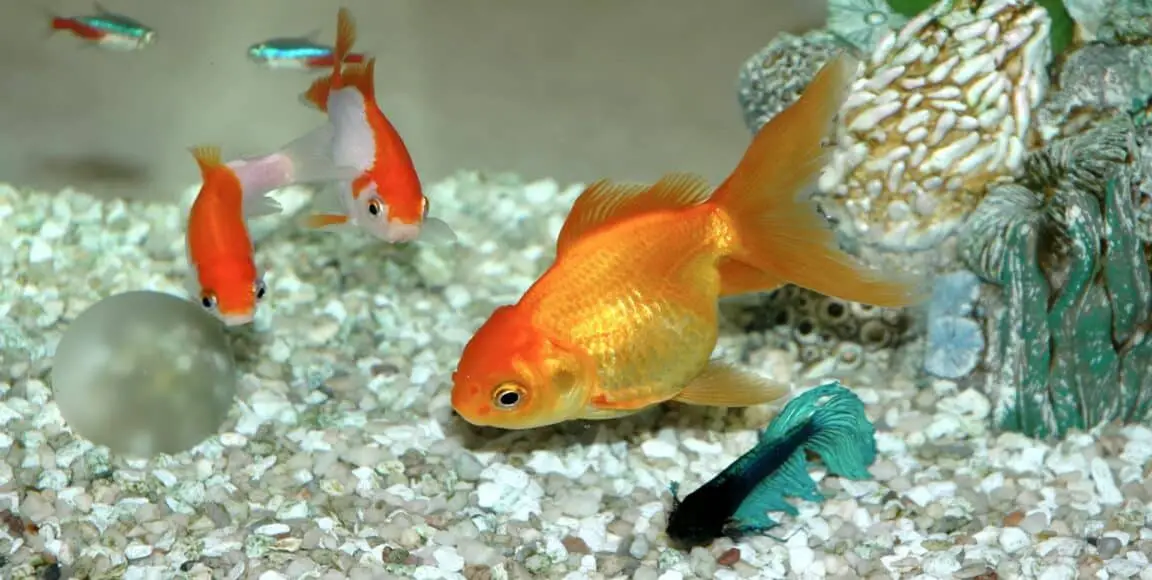Last Updated on February 17, 2023
Did you know that stress stripes on betta fish can be a sign of serious health issues?
Although stress occurs naturally in betta fish, like us humans, it can take a toll on their physical and mental well-being if left untreated.
It’s our duty as betta owners to ensure that our bettas are living in a safe and comfortable environment.
That’s why understanding what stress stripes are is crucial.
In this article, I’ll explain betta stress stripes in detail and provide great tips for making them disappear.
Table of Contents
Key takeaways
- Betta stress stripes are horizontal lines visible to female and male betta fish. However, it’s more usual for females.
- Besides the lines, a stressed betta fish can show behavioral signs like hiding, loss of appetite, and erratic swimming.
- The common reasons betta fish stripes appear are inappropriate tank size, overcrowding, poor water quality, environmental changes, and illness.
What are betta stress stripes?

Betta stress stripes are the common physical manifestation of stress in betta fish.
It appears due to a range of factors such as poor water quality, inadequate diet, and poor tank conditions.
Additionally, stressed betta fish may lose its bright colors as a reaction to different stressors. They may change, and you might observe them acting unusually.
Betta fish stress stripes are usually the first sign that something is wrong with your betta and fish tank.
And its appearance can lead to a couple of ailments like dropsy and popeye.
What do betta stress lines look like?
To help you identify stress stripes, look for light or dark horizontal lines in your betta fish’s body. They are temporary and can disappear after one or two weeks if treated.
The stripes color usually depends on your pet fish’s color.
In addition, they are visible in different parts, but they don’t usually cover betta’s body entirely.
Are betta stress stripes common to male and female betta fish?
Betta stress stripes can occur in male and female bettas, but they are more common in females.
There’s no study or further explanation as to why this is the case. But experts mentioned that male betta fish tend to lose its vibrant color instead of developing stress stripes.
It’s important to note that betta stress stripes are horizontal, never vertical.
Vertical stripes on betta fish are an indication that they are ready to breed. And unlike stress stripes, they are only visible to female bettas.
Common factors why betta stress stripes appear
Betta fish stress stripes are a sign of bad water quality and psychological stress. But there are other reasons why it develops.
Here are some you should note of:
Small betta tank

Transferring your new betta from the pet store to a permanent aquarium is already stressful for them and might take weeks to get used to – what more if you transfer them into a small tank?
Your betta’s average tank size should not be less than 5 gallons.
Since bettas love to explore and goof around, having a small tank might make their activities impossible, increasing their stress level.
Stripes appear whenever your betta is stressed out, and only having a small space to roam around will worsen their anxiety.
Knowing this, it is good to consider the size of your tank before taking your beloved bettas home.
Overcrowding
Similar to having a small tank, if your betta’s tank is overcrowded, then the living condition of your fish will be very poor – if they survive in that environment.
If you are unsure how many fish you should place inside a tank, one of the general rules is that a one-inch fish should equal one gallon of water.
However, although this is the general rule, it is still best to research thoroughly the recommended tank size for the number of fish you are planning to take care of.
Related: Betta Fish Care in a Nutshell
Poor water conditions
Maintaining proper water conditions for your fish is as important as providing them with the best environment they could live in.
Another thing to remember as a betta owner is to ensure that your tank’s pH and water temperature are right for your little friend to avoid the risk of harmful bacteria, parasites, and algae.
Sudden water condition changes
A sudden change in your tank’s water condition could cause shock and stress to your betta.
You may relate these changes to water levels, introducing new products to your tanks, such as decorations, or spraying chemicals that might be harmful to your fish.
It is important to always check your water condition and see if the products you are using are safe for your betta.
Lack of hiding place
Bettas sure do love to hide! Many toys, such as logs, shells, and caves, are available to serve as their hideouts.
Taking away one thing your betta enjoys doing will surely cause them sadness and anxiety.
Illness
Illnesses and diseases are another cause of stress for your betta, which could be parasitic, bacterial, or fungal.
If left untreated, your betta’s health will often become fatal, so it is important to check on their health from time to time.
Incompatible tank mates

If you have other fish in your tank besides your betta, it is good to examine if they are compatible with each other.
Your betta can develop stress because of other fishes without showing aggression and outward signs.
Examining your betta’s color and change in behavior when introduced to other species is a good way to notice if they are compatible with their tank mates.
If you notice this, consider if it is best to keep them inside a tank with other tank mates or if it is best to just put them in their aquarium.
Change of environment
Environmental change can come in different forms; it can be something big or a sudden small change.
Some great examples are:
- Moving your pet fish to a new tank
- Adding new tank mates
- Changes in water temperature
- Changes in lighting or water flow
- Loud noises
These types of changes can be stressful for this tropical fish and may lead to the development of stress stripes and other behavioral symptoms.
Symptoms of betta stress stripes
What are the common signs of stressed bettas? This may vary from one fish to another, but here are some common symptoms your betta might experience when under stress.
Hiding
Although bettas love to hide, stress could cause your fish to hide more than usual. If you notice your betta spending more time hiding rather than swimming around, then it is most likely that they are experiencing stress and anxiety.
Lack of appetite
Another symptom to look for is if your betta loses its appetite. If they eat less or stop, you’ll know something is wrong with your betta.
However, stress might not only be the factor for lack of appetite. Other things to consider are constipation, illness, or even depression.
Related: How Often Do Betta Fishes Poop?
Disease
Did you know that stress can cause your betta to become sick? Researchers believe that stress can increase the risk of developing diseases or illnesses.
When you have a stressed betta fish, its immune system is weak, which makes them more at risk of getting infected.
If you notice your betta might be sick, it is important to look for the cause of their stress, such as a poor environment and having tank mates.
Skittish behavior
Betta’s moving and swimming around quickly can be typical behavior.
However, if you notice your bettas are darting around constantly or swimming skittishly, they are most likely to fear something, such as their tank mates.
Behaviors to look out for when your bettas are swimming erratically are crashing and rubbing into rocks and gravel and even clamping their fins.
Changes in color
A color change could show that your beloved friend is stressed out. Your betta might change its color from its lively self into a duller and paler shade.
Aside from becoming paler, stress stripes will also appear on its skin, which could also show depression.
How to prevent or treat betta stress stripes

Now that you know what causes your betta’s stress, how and what can you prevent it from worsening?
Identifying first what causes the stress is important to make it easier for you to help your friend.
Here are some common ways you can do to prevent your betta from stressing out.
Change water frequently
Changing your tank’s water might be stressful for your betta fish, but not as stressful as not changing the dirty water.
Typically, it is good to change your tank’s water once every week or two weeks, depending on its size.
Cleaning the water reduces the amount of ammonia and nitrates, making it safer and healthier for your betta.
Use a stronger filter
Having a good and sustainable filter alongside the cleanliness of your tank’s water can help reduce your betta’s stress.
Filter helps your water tank clean whenever you are not around it. That is why investing in a strong filter is good to keep your bettas stress-free.
Just remember not to buy a filter that produces current, or else your betta might go from a 0 stress level to a 10 instantly.
Remove bully fish
Betta fish are solitary fish.
Bullies are never good news. If you notice that your betta or the other fish is becoming aggressive with one another, the best way to intervene is to separate them and transfer the other to a different tank.
Set up hiding spots
What is the best way to prevent someone from stress other than giving them the thing they love the most? In your betta’s case, providing them with hiding spaces can help reduce their stress and make them feel more relaxed.
By giving them enough hiding places, your fish will have a space to rest without the fear of being attacked by others.
Give them high-quality food
Giving your betta high-quality food can help boost their immune system and health. If you are giving them low-quality food, then start reconsidering their diet.
A low immune system could stress your fish and make them more prone to infections and diseases.
When choosing good quality food for them, feed your betta with high-quality pellets and live and frozen food.
Provide a bigger tank
As mentioned earlier, your betta fish needs at least 5 gallons of tank space to be happy and free from stress. You may have seen or heard that bettas can survive with only a 2.5-gallon tank size, but there is a big difference between surviving and happily living.
A 5-gallon tank allows you to add more decorations and provide your betta with more space to explore.
But if you’re planning to take care of a betta sorority or introduce other fish, you’ll need a bigger tank. Make sure that you have enough space for them to live comfortably.
Is stress fatal to my betta fish?
Stress in betta fish is life-threatening if not addressed promptly.
When bettas are under prolonged or severe stress, their immune systems can become compromised, leaving them vulnerable to infection and disease.
In addition, stressed bettas can lose their appetite and become lethargic, which further weakens their health.
If you notice that your betta fish is displaying stress stripes and strange physical and behavioral signs, it’s important to take action.
You may start with the above methods to treat betta stress stripes. But if they don’t work, calling a professional or visiting a local aquatic veterinarian is the best step.
Conclusion
By taking steps to minimize stress and promote the well-being of your betta, you can help to prevent serious health issues and ensure a long, happy life for your beloved tropical fish.
Treating your betta with the utmost care is the best way to prevent them from stress. Providing a safe environment for them to swim around is the greatest gift you can give your tiny companion.
Although stress is unavoidable, knowing what causes it and how to prevent it is essential. You can save your betta fish from danger and prevent any severe damage on their part.
